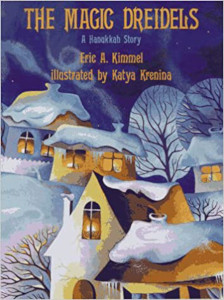The Magic Dreidels: A Hanukkah Story

Author:
Eric A. Kimmel
Illustrator:
Katya Krenina
Publication:
1996 by Holiday House
Genre:
Fairy Tales, Fiction, Folk Tales, Picture Books
Pages:
32
Current state:
This book has been evaluated and information added. It has been read but content considerations may not be complete.
Book Guide
Search for this book used on:
When Jacob tries to retrieve the new brass dreidel he dropped in a well, he comes upon a goblin living at the bottom. The goblin can't find that dreidel, but he gives Jacob something better: a magic wooden dreidel that spins out latkes, delicious latkes with applesauce and sour cream. Jacob is so excited, he shows the dreidel to his busybody neighbor, Fruma Sarah, who wants it for herself. She sneakily switches it with an ordinary dreidel. Is Jacob ever surprised when he tries to show off his new dreidel to his family! It's not magic. There are no latkes, no applesauce, no sour cream.
After the goblin gives Jacob a new magic dreidel, Fruma Sarah manages to trick him again. But he won't be fooled a third time. With a little help from his goblin friend, Jacob turns the tables on his sneaky neighbor and retrieves the magic dreidels—in time to celebrate Hanukkah!
Katya Krenina's delightful illustrations skillfully bring to life Eric A. Kimmel's charming Hanukkah story.
From the dust jacket
To view an example page please sign in.
Resource Guide
Episode 70: Why Read Fairy Tales?
Released in 2020 by The Literary Life
Available formats: Streaming Audio
Length: 1 hr. 29 min.
View on the The Literary Life site
"Angelina Stanford and Cindy Rollins tackle the topic of fairy stories, discussing the what, why and how of reading them. Angelina shares the distinctive characteristics of fairy stories in contrast to other types of stories, such as myths. They deal with the question of whether fairy tales are 'escapist', the influence of the Grimm brothers scholarly work on interpreting fairy stories, and allowing the story to unveil its deeper truths without forcing meaning onto it.
Angelina gives an illustration of how to see the gospel messages in fairy tales by talking us through the story of Sleeping Beauty. She refutes the ideas that fairy tales are about human romance or are misogynistic. She also highlights some of the Enlightenment and Puritan responses to fairy tales that still linger with us today. Cindy and Angelina also discuss some common concerns such as the magical, weird, or scary aspects of fairy tales. Angelina also makes a distinction between folk tales, literary fairy tales, and cautionary tales."
Find This Book
Search for this book used on:




